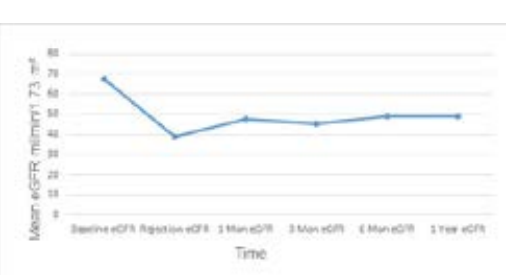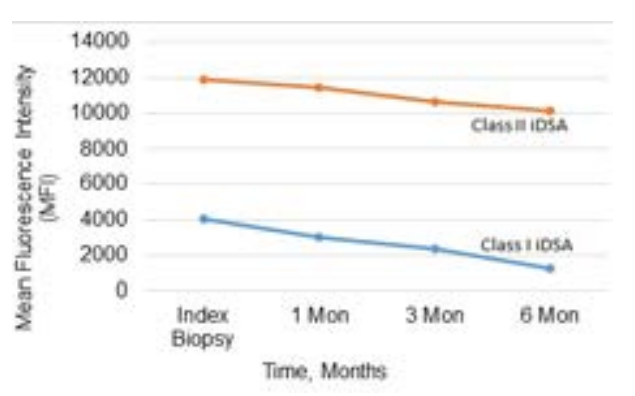1. Twombley K, Thach L, Ribeiro A, Joseph C, Seikaly M. Acute antibody-mediated rejection in pediatric kidney transplants: A single center experience. Pediatr Transplant. 2013; 17: E149-E155. doi: 10.1111/petr.12129
2. North American Pediatric Renal Trials and Collaborative Studies. 2010 Annual Transplant Report 2010.
3. Wiebe C, Gibson IW, Blydt-Hansen TD, Pochinco D, Birk PE, Ho J, et al. Rates and determinants of progression to graft failure in kidney allograft recipients with de novo donor-specific antibody. Am J Transplant. 2015; 15: 2921-2930. doi: 10.1111/ajt.13347
4. Kim JJ, Balasubramanian R, Michaelides G, Wittenhagen P, Sebire NJ, Mamode N, et al. The clinical spectrum of de novo donor-specific antibodies in pediatric renal transplant recipients. Am J Transplant. 2014; 14: 2350-2358. doi: 10.1111/ajt.12859
5. Solez K, Colvin RB, Racusen LC, Haas M, Sis B, Mengel M, et al. Banff 07 classification of renal allograft pathology: Updates and future directions. Am J Transplant. 2008; 8: 753-760. doi: 10.1111/j.1600-6143.2008.02159.x
6. Haas M, Sis B, Racusen LC, Solez K, Glotz D, Colvin RB, et al. Banff 2013 meeting report: Inclusion of c4d-negative antibodymediated rejection and antibody-associated arterial lesions. Am J Transplant. 2014; 14: 272-283. doi: 10.1111/ajt.12590
7. Kasiske BL, Zeier MG, Chapman JR, Craig JC, Ekberg H, Garvey CA, et al. KDIGO clinical practice guideline for the care of kidney transplant recipients: A summary. Kidney Int. 2010; 77: 299-311. doi: 10.1038/ki.2009.377
8. Roberts DM, Jiang SH, Chadban SJ. The treatment of acute antibody-mediatedrejection in kidney transplant recipients-a systematic review. Transplantation. 2012; 94: 775-783. doi: 10.1097/TP.0b013e31825d1587
9. Schwartz GJ, Work DF. Measurement and estimation of GFR in children and adolescents. J Am Soc Nephrol. 2009; 4: 1832-1843. doi: 10.2215/CJN.01640309
10. Minervini MI, Torbenson M, Scantlebury V, Vivas C, Jordan M, Shapiro R, et al. Acute renal allograft rejection with severe tubulitis (Banff 1997 grade IB). Am J Surg Pathol. 2000; 24: 553-558. doi: 10.1097/00000478-200004000-00009
11. Sullivan D, Ahn C, Gao A, Lacelle C, Torres F, Bollineni S, et al. Evaluation of current strategies for surveillance and management of donor-specific antibodies: Single-center study. Clin Transplant. 2018; 32 : e13285. doi: 10.1111/ctr.13285
12. Mauiyyedi S, Colvin RB. Humoral rejection in kidney transplantation: New concepts in diagnosis and treatment. Curr Opin Nephrol Hypertens. 2002; 11: 609-618. doi: 10.1097/00041552-200211000-00007
13. Pearl MH, Nayak AB, Ettenger RB, Puliyanda D, Palma Diaz MF, Zhang Q, et al. Bortezomib may stabilize pediatric renal transplant recipients with antibody-mediated rejection. Pediatr Nephrol. 2016; 31(8): 1341-1348. doi: 10.1007/s00467-016-3319-3
14. Gulleroglu K, Baskin E, Bayrakci US, Turan M, Ozdemir BH, Moray G, et al. Antibody-mediated rejection and treatment in pediatric patients: One center’s experience. Exp Clin Transplant. 2013; 11: 404-407. doi: 10.6002/ect.2012.0242
15. Dorje C, Midtvedt K, Holdaas H, Naper C, Strom EH, Oyen O, et al. Early versus late acute antibody-mediated rejection in renal transplant recipients. Transplantation. 2013; 96: 79-84. doi: 10.1097/TP.0b013e31829434d4
16. Pefaur J, Diaz P, Panace R, Salinas P, Fiabane A, Quinteros N, et al. Early and late humoral rejection: A clinicopathologic entity in two times. Transplant Proc. 2008; 40: 3229-3236 doi: 10.1016/j.transproceed.2008.03.123
17. Sun Q, Liu ZH, Ji S, Chen J, Tang Z, Zeng C, et al. Late and early C4d-positive acute rejection: Different clinical histopathological subentities in renal transplantation. Kidney Int. 2006; 70: 377-383. doi: 10.1038/sj.ki.5001552
18. Gupta G, Abu Jawdeh BG, Racusen LC, Bhasin B, Arend LJ, Trollinger B, et al. Late antibody-mediated rejection in renal allografts: Outcome after conventional and novel therapies. Transplantation. 2014; 97: 1240-1246. doi: 10.1097/01.TP.0000442503.85766.91
19. Banasik M, Koscielska-Kasprzak K, Myszka M, Bartoszek D, Zabinska M, Boratynska M, et al. A significant role for antihuman leukocyte antigen antibodies and antibody-mediated rejection in the biopsy-for-cause population. Transplant Proc. 2014; 46: 2613-2617. doi: 10.1016/j.transproceed.2014.09.028
20. KDIGO clinical practice guideline for the care of kidney transplant recipients. Am J Transplant. 2009; 9 (Suppl 3): S1-S155. doi: 10.1111/j.1600-6143.2009.02834.x
21. Waiser J, Budde K, Schutz M, Liefeldt L, Rudolph B, Schonemann C, et al. Comparison between bortezomib and rituximab in the treatment of antibody-mediated renal allograft rejection. Nephrol Dial Transplant. 2012; 27: 1246-1251. doi: 10.1093/ndt/gfr465
22. Everly MJ, Everly JJ, Susskind B, Brailey P, Arend LJ, Alloway RR, et al. Bortezomib provides effective therapy for antibody- and cell-mediated acute rejection. Transplantation. 2008; 86: 1754-1761. doi: 10.1097/TP.0b013e318190af83
23. Hideshima T, Richardson P, Chauhan D, Palombella VJ, Elliott PJ, Adams J, et al. The proteasome inhibitor PS-341 inhibits growth, induces apoptosis, and overcomes drug resistance in human multiple myeloma cells. Cancer Res. 2001; 61: 3071-3076.
24. Chromik J, Schnürer E, Meyer RG, Wehler T, Tütingb T, Wölfel T, et al. Proteasome-inhibited dendritic cells demonstrate improved presentation of exogenous synthetic and natural HLAclass I peptide epitopes. J Immunol. Methods. 2006; 308: 77-89. doi: 10.1016/j.jim.2005.09.021
25. Nencioni A, Garuti A, Schwarzenberg K, Cirmena G, Dal Bello G, Rocco I, et al. Proteasome inhibitor induced apoptosis in human monocyte-derived dendritic cells. Eur J Immunol. 2006a; 36: 681-689. doi: 10.1002/eji.200535298
26. Nencioni A, Schwarzenberg K, Brauer KM, Schmidt SM, Ballestrero A, Grünebach F, et al. Proteasome inhibitor bortezomib modulates TLR4- induced dendritic cell activation. Blood. 2006b; 108: 551-558. doi: 10.1182/blood-2005-08-3494
27. Vanderlugt CL, Rahbe SM, Elliott PJ, Dal Canto MC, Miller SD. Treatment of established relapsing experimental autoimmune encephalomyelitis with the proteasome inhibitor PS-519. J Autoimmun. 2000; 14: 205-211. doi: 10.1006/jaut.2000.0370
28. Eskandary F, Regele H, Baumann L, Bond G, Kozakowski N, Wahrmann M, et al. A randomized trial of bortezomib in late antibody-mediated kidney transplant rejection. J Am Soc Nephrol. 2018; 29: 591-605. doi: 10.1681/ASN.2017070818
29. Becker YT, Becker BN, Pirsch JD, Sollinger HW. Rituximab as treatment for refractory kidney transplant rejection. Am J Transpl. 2004; 4: 996-1001. doi: 10.1111/j.1600-6143.2004.00454.x
30. Gomes AM, Pedroso S, Martins LS, Malheiro J, Viscayno JR, Santos J, et al. Diagnosis and treatment of acute humoral kidney allograft rejection. Transplant Proc. 2009; 41 :855–858. doi: 10.1016/j.transproceed.2009.01.062
31. Faguer S, Kamar N, Guilbeaud-Frugier C, Fort M, Modesto A, Mari A, et al. Rituximab therapy for acute humoral rejection after kidney transplantation. Transplantation. 2007; 83: 1277-1280. doi: 10.1097/01.tp.0000261113.30757.d1
32. Zarkhin V, Li L, Kambham N, Sigdel T, Salvatierra O, Sarwal MM. A randomized, prospective trial of rituximab for acute rejection in pediatric renal transplantation. Am J Transplant. 2008; 8: 2607-2617. doi: 10.1111/j.1600-6143.2008.02411.x
33. Kaposztas Z, Podder H, Mauiyyedi S, Illoh O, Kerman R, Reyes M, et al. Impact of rituximab therapy for treatment of acute humoral rejection. Clin Transplant. 2009; 23: 63-73. doi: 10.1111/j.1399-0012.2008.00902.x
34. Billing H, Rieger S, Ovens J, Süsal C, Melk A, Waldherr R, et al. Successful treatment of chronic antibody mediated rejection with IVIG and rituximab in pediatric renal transplant recipients. Transplantation. 2008; 86: 1214-1221. doi: 10.1097/TP.0b013e3181880b35
35. Kamar N, Milioto O, Puissant-Lubrano B, Esposito L, Pierre MC, Ould Mohamed A, et al. Incidence and predictive factors for infectious disease after rituximab therapy in kidney-transplant patients. Am J Transplant. 2010: 10: 89-98. doi: 10.1111/j.1600- 6143.2009.02785.x
36. Puttarajappa C1, Shapiro R, Tan HP. Antibody-mediated rejection in kidney transplantation: A review. J Transplant. 2012; 2012: 193724. doi: 10.1155/2012/193724
37. Okafor C, Ward DM, Mokrzycki MH, Weinstein R, Clark P, Balogun RA. Introduction and overview of therapeutic apheresis. J Clin Apher. 2010; 25: 240-249. doi: 10.1002/jca.20247
38. Stegall MD and Gloor JM. Deciphering antibody mediated rejection: New insights into mechanisms and treatment. Curr Opin Organ Transplant. 2010; 15: 8-10. doi: 10.1097/MOT.0b013e3283342712
39. Walsh RC, Alloway RR, Girnita AL, Woodle ES. Proteasome inhibitor-based therapy for antibody-mediated rejection. Kidney Int. 2012; 81: 1067-1074. doi: 10.1038/ki.2011.502
40. Jordan SC, Quartel AW, Czer LS, Admon D, Chen G, Fishbein MC, et al. Posttransplant therapy using high-dose immunoglobulin (intravenous gammaglobulin) to control acute humoral rejection in renal and cardiac allograft recipients and potential mechanism of action. Transplantation. 1998; 66: 800-805. doi: 10.1097/00007890-199809270-00017
41. Luke PP, Scantlebury VP, Jordan ML, Vivas CA, Hakala TR, Jain A, et al. Reversal of steroid- and antilymphocyte antibodyresistant rejection using intravenous immunoglobulin (IVIG) in renal transplant recipients. Transplantation. 2001; 72: 419-422. doi: 10.1097/00007890-200108150-00010
42. Dwyer JM. Manipulating the immune system with immune globulin. N Engl J Med. 1992; 326: 107-116. doi: 10.1056/NEJM199201093260206
43. Debre M, Bonnet MC, Fridman WH, Carosella E, Philippe N, Reinert P, et al. Infusion of Fc gamma fragments for treatment of children with acute immune thrombocytopenic purpura. Lancet. 1993; 342: 945-949. doi: 10.1016/0140-6736(93)92000-j
44. Tyan DB, Li VA, Czer L, Trento A, Jordan SC. Intravenous immunoglobulin suppression of HLAalloantibody in highly sensitized transplant candidates and transplantationwith a histoincompatible organ. Transplantation. 1994; 57: 553-562. doi: 10.1097/00007890-199402270-00014
45. Negi VS, Elluru S, Siberil S, Graff-Dubois S, Mouthon L, Kazatchkine MD, et al. Intravenous immunoglobulin: An update onthe clinical use and mechanisms of action. J Clin Immunol. 2007; 27: 233-245. doi: 10.1007/s10875-007-9088-9







